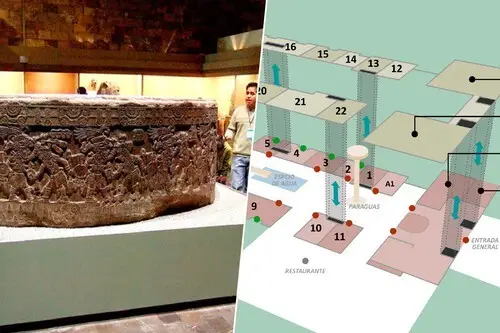
In the history of major museum robberies, the one that took place in the mid-1980s in Mexico City will be remembered forever. In addition to the seizure of a series of priceless jewels and national treasures, the theft, known in the country as “the robbery of the century,” left its mark on the way valuable cultural heritage was secured until then. What happened changed the measures forever.
A continuous visit. Today we know that in 1985 a scene was repeated for at least six months. Every day, shortly after the doors of the National Museum of Anthropology (MNA) opened, two 21-year-old students from the National Autonomous University of Mexico (UNAM), Carlos Perches Treviño and Ramón Sardina García, appeared and walked around the entire premises.
Both shared the same, almost sickly, passion for archaeology, but what the Museum’s security could not guess was that their visits had little to do with the treasures of the past that were kept there. The two young men spent six months visiting the premises to learn the routines of the guards and security of the center, and when they thought they knew everything, they marked a date in red.
Preambles. The choice of the early morning of December 25, 1985 to commit the crime was not trivial. Both students had meticulously observed the staff’s routines and noticed that surveillance was relaxed during the holidays. Christmas, therefore, had to be the perfect day.
As for their motivations, despite the fact that neither of them had a criminal record, their fascination with archaeology and pre-Hispanic art had been rising to the point of considering carrying out a plan as apparently absurd as stealing one of the largest collections of archaeological pieces in Mexico.
The robbery. The two young men knew that security that night would be minimal, or at least lower than normal. At around 1:00 a.m., they entered the museum through the air conditioning ducts, thus evading security cameras and alarm systems. That day, security, which normally patrolled the 26 rooms every two hours, was nonexistent because they had gathered to celebrate the special date.
Thus, and for three hours, they broke into several display cases and made off with 124 archaeological pieces, artifacts that included part of the Mayan, Mixtec and Mexica cultures. Among the stolen objects: gold jewelry and unique pieces, such as the Zapotec mask of the Bat God or an obsidian vase in the shape of a monkey. To give us an idea, it is estimated that the value of some of these pieces reached 20 million dollars on the black market (1985), although, as the museum explained hours later, the greatest damage was cultural and historical.
INAH bulletin to publicize the robbery
The escape. After the robbery, the students fled in an old Volkswagen and hid the pieces in the house of Perches’ parents, located in Ciudad Satélite, in the metropolitan area of Mexico City. This is one of the most remarkable points, since the stolen pieces were stored in a suitcase and remained there for almost four years without the thieves even trying to sell them, fearful of the wide media coverage and the intense police investigation that was formed.
Investigation. The truth is that the robbery unleashed a national and international scandal. The Mexican authorities were forced to act quickly after criticism of an obviously ineffective management. To do so, they deployed more than 30 investigators to solve the case, they combed all the areas, asked for international help…
But despite the efforts, the investigation did not make significant progress until 1989, almost four years after the robbery. It happened when the drug trafficker Salvador Gutiérrez “El Cabo” was arrested in Guadalajara. Gutiérrez, seeking to reduce his sentence, offered crucial information about the whereabouts of Carlos Perches and the loot.
The connection. Apparently, in 1986 Perches traveled to Acapulco where he met José Serrano, a drug trafficker of the time. The young man confessed to him that he had been one of the authors of the “robbery of the century” and began to work with him in drug sales. Later, Serrano introduced him to another drug trafficker, Gutiérrez, who allegedly offered to help them sell the archaeological pieces (they had an estimated value of around 1,000 million dollars).
As explained to Reforma by the lawyer Javier Coello Trejo, then deputy prosecutor for the Fight against Drug Trafficking, the authorities placed wiretaps in the prisons and kept track of all the calls between Gutiérrez and Perches. In one conversation, apparently, they negotiated the sale of jewelry “of the greatest art in Mexico,” which meant, at last, light at the end of the tunnel to find Perches and capture him.
Arrest and recovery. Police eventually recovered 111 of the 124 stolen pieces. This happened on June 10, 1989, after an operation in Ciudad Satélite. The pieces, including the famous Zapotec mask and the obsidian vase, were in perfect condition, although wrapped in toilet paper and stored in a sports bag at Perches’ parents’ house.
However, and despite the recovery, some pieces remain unaccounted for: seven, allegedly, remained in Sardina’s hands. The rest? Apparently, they were exchanged by Perches for cocaine, the only and unusual transaction that was made in exchange for the valuable jewels of the past.
Consequences. Perches was arrested at the age of 24 and sentenced to 22 years in prison. Sardina, meanwhile, remains missing. Perhaps more importantly, the theft exposed the obvious “holes” in the security of Mexican museums and led to the implementation of new measures, such as the installation of alarm systems, closed-circuit television and the increase of guards in cultural venues.
In short, a theft that highlighted the vulnerability of cultural heritage in Mexico until then.
Source: xataka






